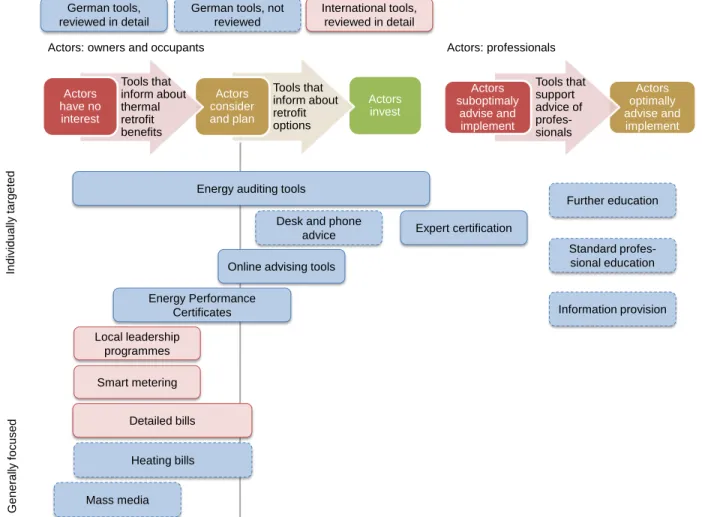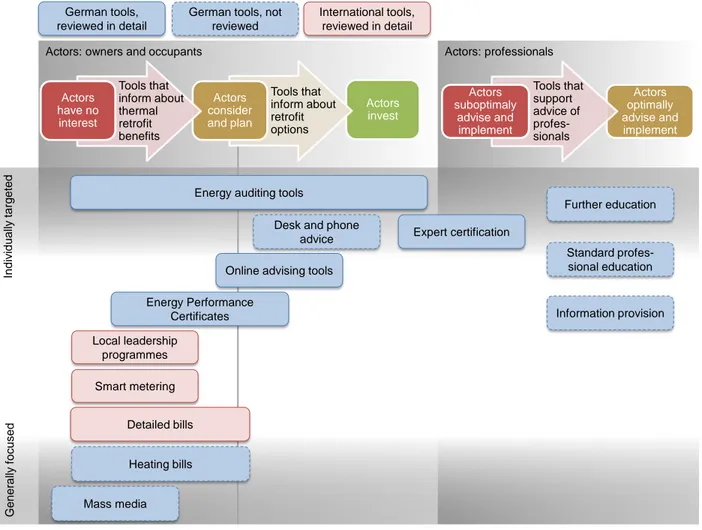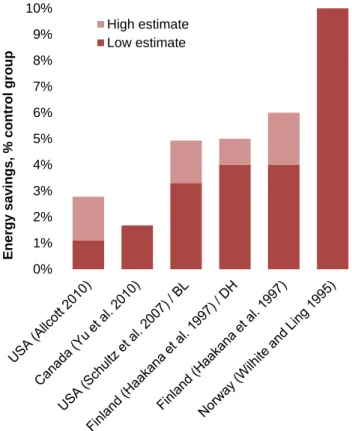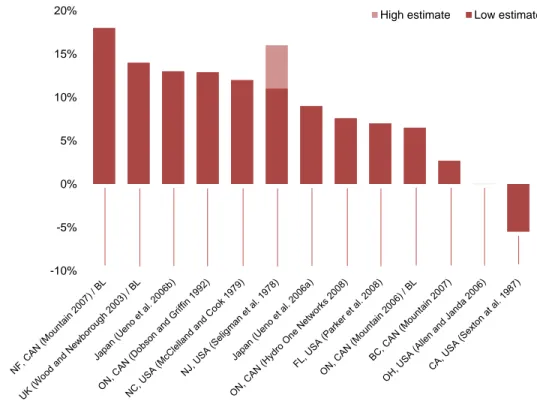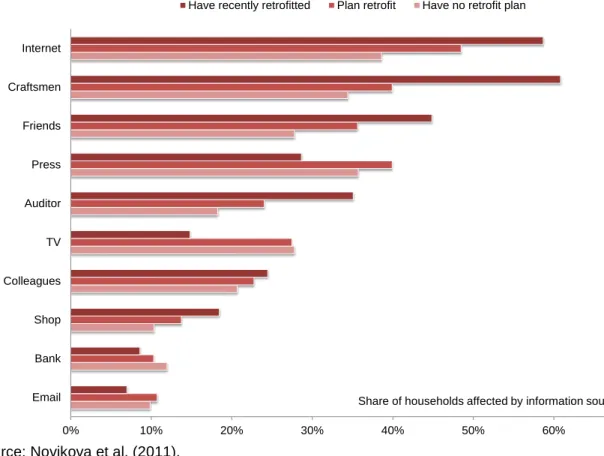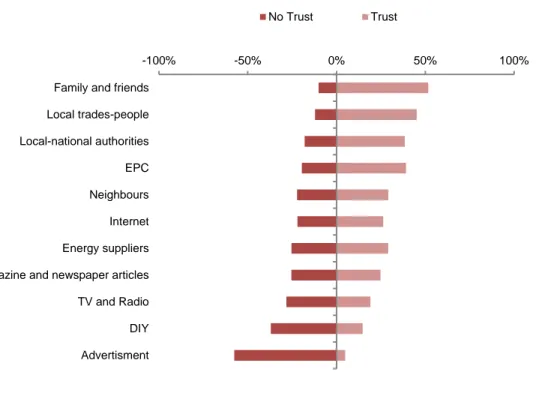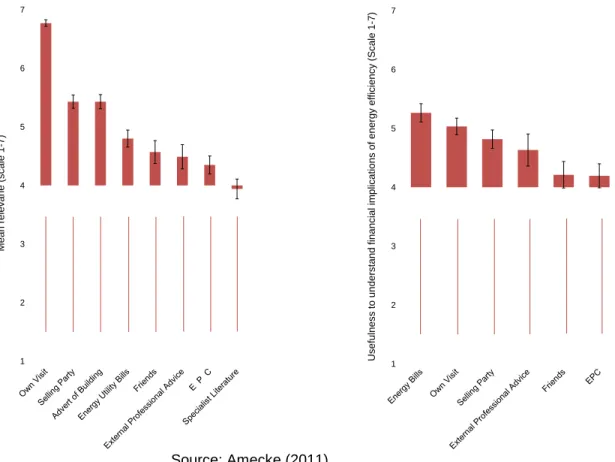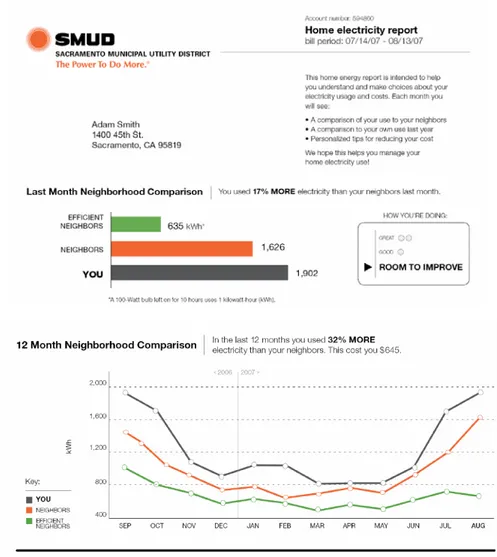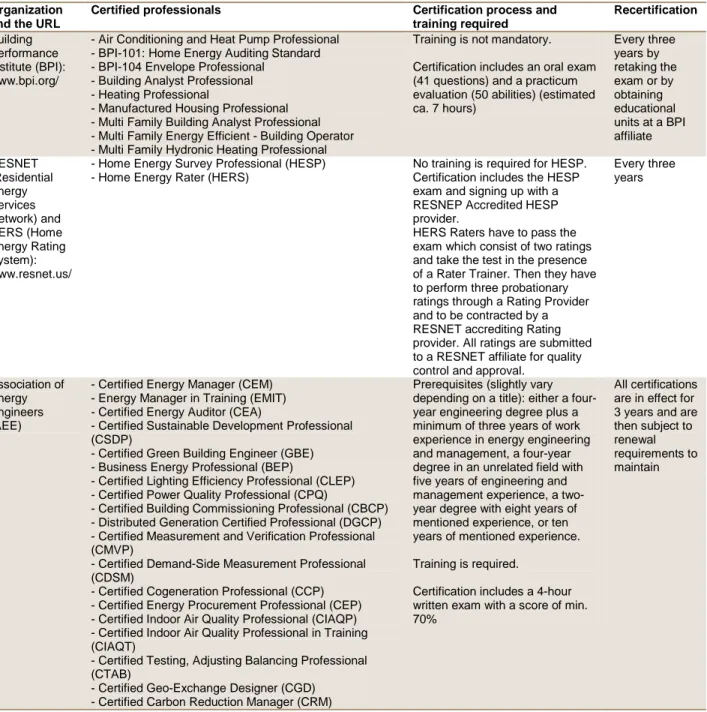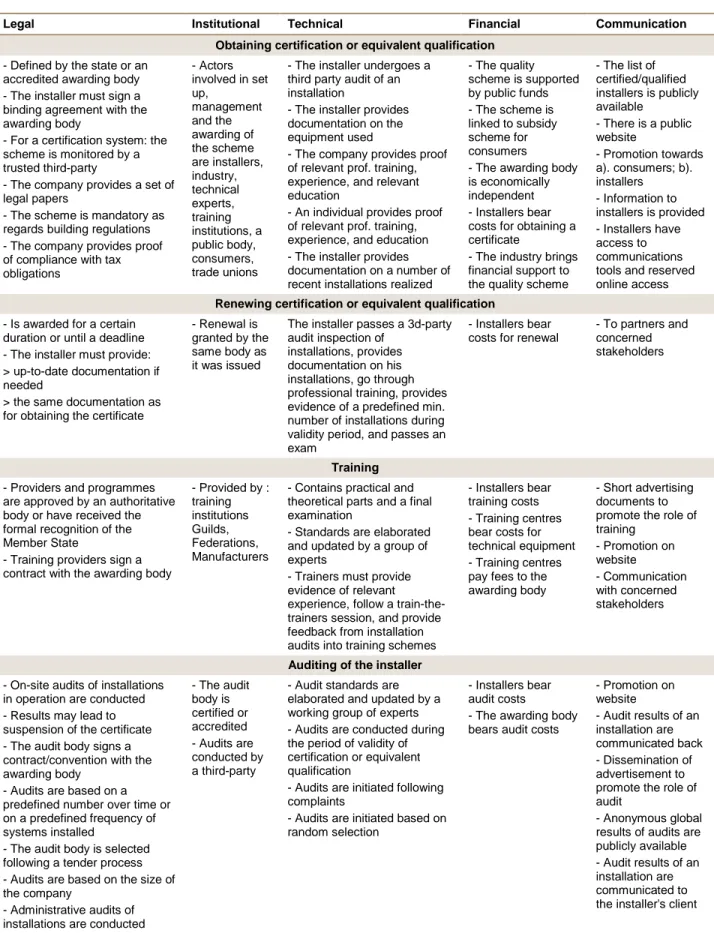Aleksandra Novikova Hermann Amecke Karsten Neuhoff Kateryna Stelmakh
Climate Policy Initiative Berlin, German Institute of Economic Research (DIW)
---
Bernadett Kiss
International Institute of Industrial Environmental Economics (IIIEE), Lund University
---
Clemens Rohde
Fraunhofer-Institut für System- und Innovationsforschung (ISI)
---
Elisa Dunkelberg Julika Weiß
Institute for Ecological Economy Research (IÖW)
---
Kaisa Matschoss
National Consumer Research Center of Finland
---
Sarah Darby
Environmental Change Institute, Oxford University
---
Information tools for energy demand reduction in existing residential buildings
CPI Report
© Climate Policy Initiative, 2011 All rights reserved
Sector Buildings
Region Germany
Keywords Buildings, thermal retrofit, information instruments
Related CPI reports “Meeting Energy Concept Targets for Residential Retrofits in
Germany”, “The Relevance of Energy Performance Certificates for Purchasing Decisions in Germany”,
“Drivers for Thermal Retrofit Decisions - Case Study of German Single- and Double- Family Houses”
Contact Aleksandra.Novikova@cpiberlin.org
About CPI
Climate Policy Initiative (CPI) is a policy effectiveness analysis and advisory organization whose mission is to assess, diagnose, and support the efforts of key governments around the world to achieve low-carbon growth.
CPI is headquartered in San Francisco and has offices around the world, which are affiliated with distinguished research institutions. Offices include: CPI at Tsinghua, affiliated with the School of Public Policy and Management at Tsinghua University; CPI Berlin, affiliated with the Department for Energy, Transportation, and the Environment at DIW Berlin; CPI Rio, affiliated with Pontifical Catholic
University of Rio (PUC-Rio); and CPI Venice, affiliated with Fondazione Eni Enrico Mattei (FEEM). CPI is an independent, not-for-profit organization that receives long-term funding from George Soros.
Co-author Affiliations
International Institute of Industrial Environmental Economics (IIIEE) of Lund University, Sweden
URL: http://www.iiiee.lu.se/
Bernadett Kiss:
Bernadett.Kiss@iiiee.lu.se Fraunhofer-Institut für System- und Innovationsforschung
(Fraunhofer ISI), Germany URL: http://www.isi.fraunhofer.de/
Clemens Rohde:
Institute for Ecological Economy Research (IÖW), Germany URL: http:/
Elisa Dunkelberg:
Elisa.Dunkelberg@ioew.de Julika Weiß:
National Consumer Research Center (NCRC), Finland
URL: //www.ncrc.fi/
Kaisa Matschoss:
Kaisa.Matschoss@ncrc.fi Environmental Change Institute (ECI) of Oxford University,
United Kingdom
URL: http://www.eci.ox.ac.uk/
Sarah Darby:
Sarah.Darby@ouce.ox.ac.uk
Executive Summary
Background and Purpose
Conducting a building thermal efficiency retrofit (or further thermal retrofit) is a long and relatively complex decision-making process involving building owners, managers, residents/tenants, and construction industry professionals. A variety of information instruments exists to support participants at each stage of this process. This paper highlights the existing literature on information instruments used in Germany and elsewhere, describing the role that they can play during different stages of the decision-making process.
Where information is available in the literature, the paper also discusses effectiveness and implementation practices.
The Residential Thermal Retrofit Decision-making Process
Figure 1 shows how the use of different information instruments can address different target groups and stages of the decision process.
Figure 1: Map of selected information instruments to support building thermal retrofit.
Actors: owners and occupants Actors: professionals
Generally focusedIndividually targeted
Local leadership programmes
Mass media Heating bills Smart metering
Detailed bills
Energy Performance Certificates
Online advising tools Desk and phone
advice Expert certification Energy auditing tools
Further education
Standard profes- sional education
Information provision German tools,
reviewed in detail
International tools, reviewed in detail
Actors invest Tools that
inform about retrofit options Actors
consider and plan Tools that
inform about thermal retrofit benefits Actors
have no interest
Actors optimally advise and implement Tools that
support advice of profes- sionals Actors
suboptimaly advise and implement German tools, not
reviewed
Information Instruments that Support Different Phases of the Retrofit Decision-Making Process We classified information tools that support the building thermal retrofit process into three categories and summarize some findings from existing literature:
1. Tools that inform about the benefits of thermal retrofits, encouraging unaware households to consider such retrofits. These tools provide basic information about building thermal retrofits and how building energy performance, energy bills, potential energy savings, health, comfort, aesthetics, and other factors are connected. Examples of such instruments include detailed energy bills, in-home energy displays, energy performance certificates, and local leadership programmes.
• The distribution of detailed bills and energy reports to all dwellings is an effective and low-cost tool. Impact is greater if participation is automated with the option to opt out rather than if explicit sign-up is required (opt-in).
• In-home energy displays, which communicate real-time information to consumers, may help raise awareness of energy efficiency benefits if consumers are educated about how to use this
information.
• Government can support local leadership programmes (informal advice networks) through the provision of training in communication and technical skills.
• Energy Performance Certificates as currently designed, e.g. in Germany, are not very effective, but they are trusted more than other forms of information and may work better once they become fully mandatory.
2. Tools that help households plan and invest in retrofits by providing information about options and financial programs. These include policy instruments and programs that can provide detailed information about retrofit options and their associated costs and ancillary benefits. Important examples of such tools are energy audits and online information instruments.
• Households trust information more if it is provided by experts rather than by internet platforms, but access to the latter is easier and cheaper.
• Online information instruments can be valuable but are at times difficult to use and do not provide tailored information to inform retrofit decisions.
• Households often perceive the advice they receive from different sources as inconsistent, limiting its value for decisions about thermal retrofits. Policies can improve the quality and consistency of advice, however. In the US, for example, a standard for building energy simulation software has been introduced.
3. Tools that train contractors and craftsmen about the retrofit process and communications. Contractors (in Germany, the term “Handwerker”, which means “craftsmen”, is used) play four roles during the retrofit process: they first suggest, plan, and implement, and then follow up after the retrofit. Programs that provide training for contractors on implementation and communication skills support these activities.
• Tools that signal and ensure the quality of experts are essential for households.
• The variety of qualifications and titles that exists undermines households’ abilities to select and trust the appropriate expert. (In the US, for instance, there are hundreds of different titles.)
• If certification schemes extend the qualification of an individual to his or her entire company, there is little incentive for contractors to train their entire staff to implement quality retrofits.
Our review of existing studies indicates that information tools could have a significant impact on the thermal retrofit of the existing residential buildings, whether the tools are implemented singly or in packages. However, further assessment of their performance along the decision process is needed.
Table of Contents
1 Introduction ... 7
2 Policies that inform about thermal retrofit benefits ... 9
2.1 Detailed billing and energy reports with a normative component ... 9
2.2 In-home energy displays and smart meters ... 11
2.3 Local-level leadership programmes ... 13
2.4 Energy Performance Certificates ... 15
3 Policies that inform about retrofit options ... 18
3.1 Online tools ... 18
3.2 Energy auditing tools and consultation ... 19
4 Policies that inform professionals ... 21
4.1 Craftsman certification ... 21
5 Conclusion ... 22
6 References ... 22
7 Appendix ... 26
7.1 Detailed bills and energy reports: case studies ... 26
7.2 Local leadership programme: case studies ... 27
7.3 Energy audits and consulting: case studies ... 28
7.4 Expert certification schemes: examples and implementation issues ... 31
1 Introduction
The German Government has committed to reduce buildings’ primary energy demand for thermal energy use in 2050 by 80% compared to 2008 levels (Energy Concept: BMWi and BMU 2010). This will require the rate of thermal efficiency retrofit of the building stock1 (plus further thermal retrofits) to more than double (from ca. 0.8%/yr. to 2%/yr.2) and will require that thermal retrofits achieve a high thermal performance for the building.
This paper classifies and reviews key information tools that have been designed and implemented in Germany. For tools that are not applied in Germany, the paper refers to international experience. The ideas reflected in the paper are based on discussions at a CPI workshop3 (CPI 2011) and the literature available in the public domain.
Conducting a building thermal efficiency retrofit is a relatively complex decision-making process involving building owners, managers, users, and construction industry professionals. A variety of information instruments exists to support participants at each stage of this process. Understanding the role of each information tool is essential for the assessment of its effectiveness. For this purpose we structure the decision-making process of households about thermal efficiency retrofit into three stages. In the first stage, households are not aware of thermal retrofit opportunities. In the second stage, they are actively considering a thermal retrofit, and in the third stage, they finally implement the plans. Information instruments can support the households in moving between these stages and are grouped accordingly.
The first group of policies moves households that are unaware or uninterested in thermal retrofit to a stage where they are actively considering and planning a thermal retrofit. These policies may provide information about a building’s energy cost or level of thermal comfort, as well as generic information about potential retrofitting options. Since uninterested actors are not actively searching for information, information needs to be made available to them in such a way that they “stumble across it.” For instance, a detailed heating bill, which reveals the financial implications of the status quo, can lead to a more positive attitude towards a retrofitted dwelling.
The second group of instruments targets households that have already considered and/or planned a building retrofit. The aim of such policies is to move interested actors to a stage where they invest in a retrofit by providing information about the performance of different retrofit options and financial support programs.
The third group of policies addresses a different group of participants, namely contractors. Contractors need to be qualified and experienced in order to effectively implement energy efficiency measures and provide thorough marketing advice and technical justifications for retrofits to their customers. This group of information instruments aims to support contractors in their activities by providing training and
information on both implementation and communication skills.
1 By thermal (efficiency) retrofit, the paper means a set of measures aimed to change the main technical characteristics of a building and its systems in order to reduce building consumption for space heating purpose.
2 Yearly retrofit rate of outer walls with insulation: 0.83% (IWU/BEI 2010).
3 “Roundtable on Information Instruments to Support Thermal Efficiency Upgrades of Buildings” hosted by CPI at DIW-Berlin on February 18, 2011 and gathered 16 regional, national, and international
representatives of ministries, energy agencies, NGOs, research institutes and consultancies.
Figure 1.1 uses the above structure to summarise the information instruments that support thermal retrofits of German residential buildings. The Figure also includes some international information policies that are not presently or have only recently been implemented in Germany.
The reminder of this paper discusses some of these information instruments. Each section provides a detailed description and definition of the policy instrument, summarizes available impact evaluations, and discusses implementation issues.
Figure 1.1: Map of information instruments to support buildings thermal retrofit in Germany and abroad
Note:
A variety of experts in the construction industry facilitate thermal retrofits of households, including contractors, chimney sweeps, architects, planners, plumbers, material producers and installers, among others. Only policies targeted at contractors are presented.
Actors: owners and occupants Actors: professionals
Generally focusedIndividually targeted
Local leadership programmes
Mass media Heating bills Smart metering
Detailed bills
Energy Performance Certificates
Online advising tools Desk and phone
advice Expert certification Energy auditing tools
Further education
Standard profes- sional education
Information provision German tools,
reviewed in detail
International tools, reviewed in detail
Actors invest Tools that
inform about retrofit options Actors
consider and plan Tools that
inform about thermal retrofit benefits Actors
have no interest
Actors optimally advise and implement Tools that
support advice of profes- sionals Actors
suboptimaly advise and implement German tools, not
reviewed
2 Policies that inform about thermal retrofit benefits
2.1 Detailed billing and energy reports with a normative component
Detailed paper or electronic energy bills give households feedback on their energy consumption.4
EPRI 2009
Detailed bills may include historical energy consumption and costs, standard or average
consumption/cost data to serve as a benchmark for comparison, on- and off- peak information where there are fluctuating energy tariffs, and/or a breakdown of energy consumption by end-use based on a representative household pattern ( ). Such feedback can also be delivered in a written “energy report” that is sent separately from the bill; there is some evidence that customers will then pay more attention, especially if the report comes from a third party rather than the utility itself. Historical energy consumption statistics include information for on- and off- peak periods, which is available at the utility level and can be prepared by utilities themselves at insignificant costs. Bills with historical statistics are a standard practice in California and many other US utilities; they are also a legal requirement for utilities in New South Wales, Australia (Roberts and Baker 2003).
Figure 2.1 summarizes various studies’ impact evaluations of the inclusion of historical and normative data in energy bills and energy reports. Estimates for a reduction in household energy consumption versus control groups range from 1%-10%, with a median of ca. 5%. Based on a detailed review of feedback experiments, (Darby 2006) argued that the reasons for variation include the information content and its quality, while Abrahamse et al. (2005) cautioned about the reliability of estimates due to the variability in experimental conditions, such as sample size and the presence or absence of appropriate control groups.
A review by Schultz et al. (2007) noted that normative feedback can lead to a negative impact on energy conservation behaviour for a sub-group of households with above average energy performance.
Providing an encouraging injunctive message (such as an “” icon), however, may partially neutralize this effect (see also Allcott 2010).
4 For an overview of all feedback tools please see Darby (2010), Ehrhardt-Martinez et al. (2010) and EPRI (2009).
Detailed energy bills and reports with a normative component (information on local averages or norms) are cost-effective and may result in 1-10% energy savings.
• The impact of these tools is increased if participation is automated with an option to opt out, rather than requiring explicit sign-up (opt-in).
• To neutralize the possible negative effect of the normative information on consumers who are using less energy than the average household, the design of bills should include positive reinforcement messages.
• There are two ways of dealing with household data access and security: requesting them on a voluntary basis or establishing a third party responsible for data collection and treatment.
• Experts recommend feedback hotlines to address concerns and remove households that wish to discontinue receiving this information.
Figure 2.1: Electrical energy savings
resulting from detailed billing/written energy report experiments as compared to control groups (for the case marked “DH,” district heat savings are examined; for the case marked “BL,” heating savings
versus the baseline equal to the last period consumption are provided)
Available estimates (Allcott 2010; Wilhite and Ling 1995) attest that historic and normative feedback can be very cost-effective, reducing energy consumption at costs of US$0.01/kWh to US$0.04/kWh (see Figure 2.1). Allcott (2010) calculated that the impact of detailed bills in a US case study has been equal to a 17-28% increase of the residential power tariff, given the low price elasticity of electricity demand (see Case study 1 of the Annex).
Large scale implementation of detailed billing schemes, however, is still rare. The US company OPower and the Canadian utility BC Hydro are two examples and are described in Case study 1 and Case study 2 of the Annex, respectively. The OPower scheme enrolls all households by default and offers an opt-out option, whereas the BC Hydro programme requires a subscription (opt-in). Carroll et al. (2009) argued that offering an opt-out option may be more effective, because few people choose to opt out. While the sample selection bias might result in a higher energy savings rate for participants in opt-in schemes, in these two cases, the overall impact of opt-out schemes was higher given the higher participation rate.
Further success factors include frequent reminders about the programme, such as newsletters, which in BC Hydro’s case may have increased traffic to the online tool (Carroll and others 2009). Credibly conveying to householders that they are being compared to a valid comparison group remains a
particular challenge (ibid.). Thus, the authors recommended feedback lines to address such concerns or to remove households that wish to discontinue receiving this information.
Data access, management, and privacy issues need to be carefully addressed during implementation.
OPower, a third party provider, delivers energy consumption feedback to utility customers as a ready product. Thus only OPower has access to household statistical information. In contrast, utility provider BC Hydro receives household information from consumers and analyzes it in-house.
0%
1%
2%
3%
4%
5%
6%
7%
8%
9%
10%
Energy savings, % control group
High estimate Low estimate
Figure notes:
USA (Allcott 2010): historical and normative feedback produced by a private company OPower for 23 US power utilities to inform ca. 600,000 customers since 2008, the data is as of early 2010.
USA (Schultz et al. (2007): normative feedback to 287 California power customers in 2005 immediately after sending the reports and 4 weeks later. These results are for a group of households which consume moreenergy than average (see below).
Finland (Haakana et al. 1997): normative feedback about power and district heat consumption to 105 Finnish single-family houses during 21 months in 1993-1995.
Canada (Yu et al. 2011): historical and normative power consumption feedback of the Power Smart programme by the British Columbia utility BC Hydro to ca. 300,000 customers since 2008 (the number of customers is as of early 2011 according to the BC Hydro website).
Norway (Wilhite and Ling 1995): historical feedback on power consumption of 1286 Norwegian customers during 3 years starting from 1989; impact of normative feedback was not quantitatively estimated.
2.2 In-home energy displays and smart meters
In-home energy displays reveal real-time information to consumers about their electrical energy consumption and respective payments, in contrast to classic electrical meters, which only measure the total amount of energy used. Smart meters provide detailed information about energy usage patterns (e.g. energy consumption for individual electrical appliances), as well as other smart grid services, through the electricity grid.
Since 2010, households in Germany have been required to install smart meters when a meter is replaced or installed for the first time or when a building undergoes major renovations (German energy economy law (EnWG 2005), which implements the Directive 2006/32/EC (European Commission 2006).
The displays and smart meters are meant to change user behaviour by providing information about the energy consumption pattern and identifying ways to save energy. Reviews by Darby (2010) and Ehrhardt- Martinez et al. (2010) indicate that overall savings can reach 20% or more for some motivated individuals, but that a saving of closer to 5% (against controls) is a more realistic expectation for large samples of householders who use feedback displays regularly.
Figure 2.2 compares the impact of displays on energy consumption patterns as compared to the control group. Some of the key factors influencing the size of impact are the accompanying informational campaigns (Stromback and Dromacque 2010) and the previous consumption habits of the users (Aune 2001).
The payoff of a smart meter installation depends on the system’s installation cost. Especially for smaller households with a low reduction potential, the economic break-even may not be achieved within the meter’s lifetime if only energy saving is considered (Stromback and Dromacque 2010). In addition, in most markets, where supplier profits are not decoupled from sales (as they are in some US states), energy suppliers have no incentive to help customers reduce their energy use. In order to address this barrier, the Directive 2006/32/EC (European Commission 2006) requires companies to help their customers reach 1.5% energy savings in their electricity consumption (Neslen 2011). For energy suppliers, smart meters may also be a tool for load balancing.
User education is crucial for the successful implementation of a smart metering system, as a smart meter alone does not save energy. The implementation of smart meters must be supported by information campaigns that take into account consumer psychographics. Consumers may also need access to capital, where inefficient appliances have been identified and need to be replaced. Finally, to encourage energy efficiency improvements, consumers need financial and other motivations. If the financial impacts of retrofits are low, consumers are less likely to pursue these retrofits.
In-home energy displays reveal real-time information to consumers about their energy consumption and respective payments. Households that use the display regularly may save 5% of electricity. This points to opportunities for providing ‘real-time’ information about energy consumed for heating
(typically gas, oil, district heating), which is currently only available on monthly or less frequent bases.
Studies suggest that in order to meet the potential of these displays/smart meters, policymakers should address:
• Utilities’ motivation to encourage consumers to reduce consumption (decoupling profit from sales or requirements to help customers reach a particular energy savings goal).
• Information campaigns to educate consumers on how to use the information from energy displays and smart meters.
• Policies to motivate consumers to act on the information (e.g., financial incentives).
Figure 2.2: Energy savings resulting from installation of electricity displays as compared to control groups
(for the cases marked “BL,” heating savings versus the baseline equal to the last period of consumption are provided)
Source: constructed based on (EPRI 2009).
Figure notes:
• Newfoundland (NF), Canada (CAN) and British Columbia (BC), Canada (CAN) (Mountain 2007):
real-time feedback monitors in the houses of 200 Newfoundland Power and BC Hydro customers were monitored in spring and summer 2005 with a 3.5-year follow-up.
• UK (Wood and Newborough 2003): energy consumption indicators (ECI) attached to cooking devices in 20 households were monitored over a 2-month period; 10 of the households also received an information pack.
• Japan (Ueno and others 2006b): 9 houses were given access to an on-line, interactive
information system that displayed appliance-specific and household energy consumption for 1.5 months; 10 houses were given access to a similar system that displayed household gas and power consumption as well as household temperature for the same time period.
• Ontario (ON), Canada (Dobson and Griffin 1992): electricity cost speedometers west installed in 25 households through homeowner’s personal computers; the speedometers showed electricity costs over two months on hourly, daily, monthly and annual bases with the data broken down by end-uses.
• North Carolina (NC), USA (McClelland and Cook 1979): Fitch Energy (electrical) monitors showing electricity costs at particular times of day were installed in 25 new houses connected to the grid and with fluctuating power tariffs and were monitored over 11 months.
• New Jersey (NJ), USA (Seligman and others 1978): consumption feedback was given to 10 households during 4 weeks during the summer in the form of a light that flashed when the
-10%
-5%
0%
5%
10%
15%
20%
Energy savings, % control group
High estimate Low estimate
outdoor temperature cooled below 68F, indicating that the could be cooled without air conditioning by opening the windows.
• Japan (Ueno and others 2006a): graphical displays given to 9 Japanese households, showing their energy use broken down by different end-uses and energy prices and historic energy use provided by past bills over 2 months.
• Ontario (ON), Canada (CAN) (Hydro One Networks 2008): in-home display monitors installed for 500 residential, farm, and small general service (under 50 kW) distribution customers between May and September 2007.
• Florida (FL), USA (Parker and others 2008): in-home displays (Energy Detectives) showing real- time and cumulative electricity consumption for the month, daily and monthly peak electrical demands, and energy costs in 17 homes with a 1-year follow-up.
• Ontario (ON), Canada (CAN) (Mountain 2006): real-time feedback monitors in 382 detached family homes in different geographical locations and climate zones monitored from summer 2004 to autumn 2005; the reduction in electricity consumption depended on whether a house used electricity for space and/or water heating.
• Ohio (OH), USA (Allen and Janda 2006): 4 displays (Energy Detectives) showing power consumption and costs in low-income households and 6 of the same displays in high-income households over three months.
• California (CA), USA (Sexton and others 1987): in-home display monitors showing peak period, off-peak period, and total consumption installed in ca. 50 households.
2.3 Local-level leadership programmes
Peer communication through networks of neighbors, friends, building societies, and industrial
associations may be an efficient way to deliver information, because it offers relevant experience and is trusted (CPI 2011; Heiskanen 2010). Survey results in Figure 2.3 show that friends and colleagues combined are a more important source of information for households than other sources. Local initiatives, often driven by strong leaders (who are building residents in some cases), have been successful in creating networks that leverage personal relationships to communicate information. Public programs can provide support (incentives, training, and information) for individuals to replicate such initiatives. Case studies 3 – 6 of the Annex review four local-level leadership programmes: the Energy Environment Experts of Finland, and the Bygga-Bo-Dialogen, Bebo, and Belok associations of Sweden. The impact of and implementation lessons from these case studies are summarized below.
Available assessments of the leadership programmes reviewed concluded that they had a positive impact on the thermal retrofit process whether these programmes were implemented on their own or in a
package with other tools. The total direct savings of the Finnish Energy Expert programme through 2010 were estimated to be 14% of the total CO2 emission saving requirement proposed in the Energy Saving and Efficiency Program (Heiskanen and Aalto 2010; TEM 2009). BeBo and Belok programmes
contributed to technology procurements, some of which resulted in 30-50% energy and cost savings (BeBo 2011).
Peer communication through local leadership networks, such as neighbours, friends, building and industrial associations, may be a low-cost, efficient way to deliver building upgrade advice.
• The impact of peer communication depends on the social and technical skills of local leaders and their motivation.
• In addition to their direct immediate impact, such communications establish the culture of energy knowledge and ultimately multiply the learning that takes place among individuals.
• Public sector support (training, incentives, and guidance) is essential for network success.
• It is difficult to find appropriately skilled volunteers to communicate information and advice.
Figure 2.3: Percentage of households affected by different sources of information about energy efficiency retrofits
Source: Novikova et al. (2011).
Notes:
• Households were allowed to identify multiple sources of energy efficiency information. Therefore, the percentages for different information sources do not total 100%.
• Sources of information may be linked to each other. For instance, a friend may provide advice on how to find a good supplier/builder.
• Figure 4.1 does not take into account the type and quality of information received.
The local leadership programmes have also been found to be cost-effective. Thus, the energy savings of the Bygga-Bo-Dialogen programme are estimated (qualitatively) to be greater than its costs (Swedish National Board of Housing and Planning 2009) .The costs of the Finnish Energy Expert programme were estimated to be low – in the small town of Jyväskylä, for instance, the cost was ca. EUR 200 per trained expert (Heiskanen and Aalto 2010). Belok was also evaluated as an “inexpensive mechanism,” but again, only limited attention has been paid to evaluation of activities (Nilsson 2006).
The impact of the local leadership programmes depends on several factors. The first is the
communication and technical skill of the leaders. The second factor is the extent, scope, scale, and effectiveness of programme activities. Impartial and objective advice is needed in the market where there are several competing solutions and where businesses only provide information about their own
solutions. Results from focus group discussions suggest a role for government in providing monetary support, recognition, and communication and technical training (Heiskanen and Aalto 2010).
Darby (1999) states that a supply of energy advice is important to society. Although it may not lead to immediate action, qualified advice creates a culture of energy knowledge and know-how through learning that takes place between individuals (Heiskanen 2009; Strand 2010).
0% 10% 20% 30% 40% 50% 60% 70%
Email Bank Shop Colleagues TV Auditor Press Friends Craftsmen Internet
Share of households affected by information sources Have recently retrofitted Plan retrofit Have no retrofit plan
The obstacles facing the local leadership programmes, making them less effective, often relate to the personal skills required by this tool. Some local leaders may lack the necessary communication skills or may abuse the position to intervene in other people’s lives (Heiskanen and Aalto 2010). The continuity of programs and cooperation among participants can pose additional challenges, and the identification and engagement of skilled people is a further difficulty, particularly where programs rely on volunteers.
2.4 Energy Performance Certificates
Energy Performance Certificates (EPCs) are mandatory comparative labels that assess the performance of residential and commercial buildings. EPCs were introduced with the European Performance of Buildings Directive (EPBD) of 2002 (European Commission 2002) and were gradually implemented in all Member States. The information instrument pursues two main aims:
• Motivating building occupants and owners to pursue thermal retrofits by revealing the status quo of a building’s energy performance and highlighting the options for efficiency investments.
• Motivating potential purchasers and tenants to choose an energy efficient building by revealing information about the energy performance of different purchasing/renting choices (thus also contributing to an increased resale value of energy efficient buildings, which in turn supports thermal retrofits as profitability increases).
Member States had considerable discretion in the implementation of the EPC concerning the numerical indicator that describes a building’s performance (e.g. kWh/m2/a or GJ/a), concerning the design of the label (continuous or categorical), the calculation method (either based on calculation, measurement, or both), the choice of additional information (e.g. inclusion of financial indicators and/or CO2 emissions), and the compliance control mechanisms (e.g. spot checks or not). Hence, each country’s implementation of and experience with EPCs varies (see BMVBS 2010; BPIE 2010; Dorß and Elstner 2009 for
comprehensive overviews).
The impact of EPCs on modernization decisions differ. Hansen Kjaerbye(2008), for example, found that the Danish labelling program, which served as a blueprint for the EPC, had no impact on actual energy consumption. Togeby et al. (2008) concludes that EPCs are not cost-effective, as the costs for the whole labelling process are high compared to the small outcome of the instrument. In the UK, on the other hand, Lainé (2001) concluded that 17% of respondents acted on the recommendations of the EPC and NHER (2009) found that 32% of respondents implemented some of the EPC recommendations. Gram-Hanssen et al. (2007) suggested that it is difficult to directly measure the impact of an energy label, because, among other reasons, house owners react to the recommendations of the EPC only if the information is also supported by their social network and other sources.
Estimates of the impact of EPCs on purchasing decisions also vary. A CPI-survey among 700 purchasers of resident dwellings in Germany found that the EPC was one of the least relevant information sources to home purchase decisions (7th out of 8, see Figure 2.5 for details), though still 50% of respondents, that
Energy Performance Certificates (EPCs) inform occupants/owners about the energy performance of buildings as well as thermal retrofit options and support purchasers/tenants in choosing efficient buildings. Thus, EPCs can also support investment in thermal retrofit by reflecting the thermal
performance in the resale value of the building. At present, however, the impact of EPCs is still limited, because:
• Though EPCs are one of the most trusted information sources relative to others, they still achieve only a low level of absolute trust;
• The information they provide might not fully match household needs – for example, energy consumption is not translated into financial implications; and
• EPCs are frequently unavailable or are not presented for dwellings.
The update of the EPBD (European Performance of Buildings Directive), however, could increase the impact of EPCs in the future as the relevance of the certificate is suggested to increase if it is shown more frequently to purchasers.
used the EPC, indicated that the certificate was at least somewhat relevant (Amecke 2011). In England, Lainé (2001) found that only 18% of respondents stated that the EPC was influential in the purchasing decisions. Adjei et al. (2011) found that the information in the EPC was not used as a negotiation instrument in respondents’ purchasing processes.
The above results indicate a moderate to low impact of the EPC. The following points can provide explanations:
1. Purchasers largely do not trust the EPC, but they trust it more than other information sources.
While Amecke (2011) and Gram-Hanssen (2007) find that trust in the energy labels for buildings is rather low in absolute terms, Adjei et al.’s (2011) results show that despite low absolute values, the EPC is one of the most trusted information sources relative to others (Figure 5.2). The latter finding could suggest that the EPC can play an important role as a government backed
information instrument.
Figure 2.4: Trust attached to different sources of information in several European countries
Source: Adjei et al. (2011).
2. The EPC does not provide the information that purchasers need most: Adjei et al. (2011),
Amecke (2011), and Stieß et al. (2010) find that financial implications matter most for investments in energy efficiency. However, the responses in the latter study indicate that the EPC was the least useful information source for assessing the financial implications of the energy performance of dwellings (Figure 2.5). One explanation could be that EPCs in most EU countries do not translate the energy rating into monetary terms. Thus, translating the information on annual energy demand/consumption into estimated annual energy costs could increase the relevance of the EPC. Yet, according to Adjei et al. (2011), purchasers in the UK do not find the EPC more useful for assessing financial implications even with the inclusion of financial indicators. How much of this is due to specific problematic factors with the underlying calculations and display in the UK requires further research (Banks 2008).
-100% -50% 0% 50% 100%
Family and friends Local trades-people Local-national authorities EPC Neighbours Internet Energy suppliers Magazine and newspaper articles TV and Radio DIY Advertisment
No Trust Trust
1 2 3 4 5 6 7
Mean relevane (scale 1-7)
Figure 2.5: Relevance of information sources to home purchase decisions (left) and their usefulness for understanding the financial implications of energy efficiency (right)
Source: Amecke (2011).
3. Currently, some countries do not require that the EPC be actively displayed when letting or selling a residence for existing buildings. In Germany, for example, the EPC was available for only 38%
of households in contrast to 69% in England (Adjei and others 2011).
4. Energy efficiency plays only a minor role in purchasing decisions, ranking 9th out of 13criteria in Amecke’s study (2011) and 9th out of 12 in Adjei et al.’s study (2011). The relevance of the EPC depends on the relevance of the criterion that it informs. Increasing the relevance of energy efficiency to purchasing decisions will require complementary policy instruments.
The 2010 recast of the Energy Buildings Performance Directive (European Commission 2010) requires that the results of the EPC be published for all buildings in building advertisements and that Member States implement a compliance control system. This is expected to increase the relevance of the EPC, as the EPC was significantly more relevant to purchasing decisions when shown more frequently to the purchaser (Amecke 2011).
Figure note: The trust vs. distrust responses shown in the graph do not add up to a 100% because the graph includes 5%-8% missing responses (either because respondents ticked 'don't know' or for other reasons); the remaining responses not shown in graph have fallen into the 'neutral' category.
1 2 3 4 5 6 7
Usefulness to understand financial implications of energy efficiency (Scale 1-7)
3 Policies that inform about retrofit options 3.1 Online tools
Desk- and web-based building energy analysis software for the general public has become widely available during the last two decades. The high penetration rates of the Internet have made such tools increasingly popular. According to our knowledge, the largest software tools are:
• Building Energy Software Tools Directory by the U.S. Department of Energy, URL:
• Tools to Support Energy Savings on the website of the BUILD-UP initiative established by the European Commission, URL:
• Tools listed on the Intelligent Energy e-Library by the European Commission, URL:
• Energy Analysis Software database by TenEcoLinks, URL:
• Energy Solutions Database by Western Area Power Administration of U.S. Department of Energy, URL:
According to one study, the Internet is one of the most powerful advisory tools for household thermal retrofits (Novikova and others 2011). Figure 2.3 ranks Internet self-search as the most popular source of information for building household awareness and assisting with planning a building thermal retrofit (though the results are somewhat biased since the survey was conducted through the Internet).
Other studies reviewed the Heizcheck (Heating check) and Modernisierungsratgeber (Modernization evaluator) online tools designed by the German company co2online. The evaluation of Heizcheck (Friedrich 2006a) concludes that it resulted in ca. two-thirds of households conducting thermal retrofits;
one-third of these households lived in rented dwellings, while the remaining households owned dwellings.
Of the household owners, the tool was a principal trigger for 25% of retrofits and contributed to 60%, resulting in incremental efficiency investments of EUR 223 million and EUR 586 million respectively.
Where it was used, Modernisierungsratgeber has been the main trigger for 9% and a contributor to 27%
of building thermal retrofits (Friedrich 2006b). Overall, 91% of households that used the tool have recently conducted or plan to conduct building thermal retrofits.
The figures suggest that online energy analysis tools have a significant impact on building thermal retrofits. However, because of the limited evidence, the results should be treated with caution.
Mills and Ritschard (1987) developed methodologies for evaluating and comparing software tools based on criteria such as the information collected from households, technical parameters, analysis methods, output types, and user services (glossaries, FAQs, in-built program help, and others). Applying this methodology, Mills (2004) compared 50 web-based and 15 desk-based residential energy analysis tools designed in North America. Using twelve tools to calculate energy use and cost for a model building, the author found a wide range of results, with the largest value two to three times that of the smallest. In fact, some software with a relatively small number of inputs accurately estimated energy consumption and suggested appropriate retrofit options, whereas other software that required numerous inputs still omitted
Online tools for residential thermal retrofits are among the most popular sources of information through all stages of the decision-making process. They provide information at a low cost per household.
• Tailoring software to consumer needs and balancing the level of complexity, accuracy, and use time required to obtain the desired output are the key design issues.
• Online tools should include information about the co-benefits of energy efficiency and the reasons for possible deviations between estimated and actual data.
• Analysis of such key issues as thermal performance and other opportunities for improvement is required.
• Quality control and constant improvement are important for gaining the trust of users.
key issues. The reasons for conflicting results were difficult to track without programming documentation, which is rarely available for online tools. For this reason, the author called for unified initiatives for software development. One example of a quality control attempt is the ASHRAE standard 140, which prescribes testing methods to identify and diagnose differences in building energy simulation software (ASHRAE 2007).
Mills (2004) concluded that no single tool is “perfectly designed” and possesses all desirable
characteristics. Key design problems include too much time required to use the software, extensive input needed from users, and output data formats that do not meet consumer needs. The author suggested tailoring software to consumer needs by providing things such as what-if information. Also, the author found that many tools evaluate miscellaneous energy uses and provide spot tips while key issues and comprehensive retrofitting packages including simple but cost-effective options are rarely suggested.
In contrast, Westerman (2001) suggested that software packages should offer targeted evaluation of simple measures by request rather than requiring the whole procedure of building energy analysis. This report also emphasized the usefulness of attaching to results the reasons for possible deviation of actual energy consumption and cost data from the estimate, as well as tips on the non-energy benefits
associated with suggested options.
Finally, online energy analysis software is a very cost-effective measure. Once created, it can be used for a long time and distributed at low cost. For instance, the online Home Energy Saver developed by the Lawrence Berkeley National Laboratory and financed by the US Department of Energy is distributed via social media (URL:The average cost of online software may be close to USD 0.5 per household whereas the cost of home energy audits may vary from ca. USD 40 to thousands of dollars (Michaels 2002). Mills (2004) emphasizes the importance of proper financing for maintenance and quality control of online tools to improve accuracy and in turn users’ trust in the tools.
3.2 Energy auditing tools and consultation
According to the European Directive on energy end-use efficiency and energy services, an energy audit is defined as a systematic procedure that analyzes and evaluates the energy consumption of a household or company (European Commission 2006). The purpose of energy audits is to identify cost-effective energy saving measures. According to the directive, energy audits shall reach all end users, including households and commercial and industrial consumers; in this article we focus on energy audits for private households. In this paper, the term energy audit is defined more broadly than in the European Directive to include face-to-face consulting without comprehensive documentation.
Several studies found energy audits and consulting on household and building energy consumption to be effective and cost-efficient measures for triggering energy-saving measures.
• Auditing tools should be used with caution; interpreting the results requires expert knowledge, and it is important that consultants explain the results and uncertainties.
• Energy audits and consultations of varying complexities and costs can target households with different needs.
• Interested parties often do not know what they will get for their money, since the quality of energy consulting can vary significantly. It is essential to inform each client on the topics included in, the products of, and limits of a specific consulting engagement before taking action; otherwise the project may not fit with expectations.
• Local independent institutions that coordinate energy consultation offers from various suppliers and provide an advice hotline can help households find a suitable offer.
Energy auditing tools are used to analyse the thermal quality of buildings and industrial plants as well as the energy efficiency of technical equipment, such as heating systems and air conditioning equipment.
Computer programs are one tool used to calculate the heating and/or primary energy demand of a building and its potential energy savings through specific measures (see e.g.Crawley and others 2008;
Poel and others 2007). Another well-known tool is infrared thermography used to detect the source of energy leaks in a building’s envelope (Balaras and Argiriou 2002). Energy consultations, assessments, or advice generally accompany the use of such tools but can also accompany simpler tools. They also vary strongly in complexity, the type of supplier, and format (face to face, via internet, or even by phone). The energy consulting community agree that a homeowner accepts different levels of information step-by-step before implementing thermal retrofit options. Thus, the low-level consulting provides an assessment of building energy performance on the basis of easy available data while the detailed consulting derives the advice based on precise data sampling on site and its analysis with certified computer programs.
Case studies 7-9 in the paper Annex describe the following energy consultation types and tools available in Germany and abroad:
• Low-level, free ‘energy checks’ in Germany based on a short questionnaire focusing on easily available data (Case study 7)
• Initial low-cost energy consultations, which deepens the knowledge of households about energy saving, available in Germany, Finland, and Sweden (Case study 8)
• The more expensive, detailed, and standardized energy consulting program in Germany called
“BAfA-Vor-Ort-Beratung” (Case study 9)
Various studies review the impact of the different types of consulting programs.
After receiving a low-level energy check, a third of all users made use of a more detailed, fee-required energy consultation, and half of users implemented an energy saving measure (Germany, produkt+ markt 2009). A major obstacle for investments in energy efficiency is often the customer's lack of required resources, such as time, knowledge, and money (Schliech 2004). Energy checks address these
obstacles, providing information that is easily accessible, free of charge, and requires almost no previous knowledge on the part of the homeowner. However, since most of the suppliers of free energy checks are contractors (e.g., heating engineers or chimney sweepers), energy saving potentials in building components that are not their specialties can be overlooked or underestimated.
After a low-cost energy consultation, 78% of all users in the Region Hannover implemented at least one energy-saving measure, investing, on average, EUR 30,000 (Germany, Klimaschutzagentur Hannover).
At the same time, fewer than 20% subsequently made use of a more detailed consultation or energy audit (Stieß and Birzle-Harder 2010). According to ex-ante estimates (TEM 2009), by 2020, energy consulting programs in Finland could reduce the total national CO2 saving requirement by 0.5%. Heiskanen (2011) suggested that without adequate financial support, low quality energy counselling might provide inferior advice and thus result in negative impacts.
After the detailed Vor-Ort-Beratung program more than 90% of all users implemented energy saving measures or stated that they planned to do so in future (IFEU 2008). Also,more than 80% of users were satisfied with this type of consulting; in particular, the consultant’s expertise and independence were seen in a positive light.
The project ENEF-Haus conducted in spring 2009 estimated a share of households, which ask for advice before implementing building thermal retrofits. For this, the project surveyed ca. 1,000 homeowners of single and semi-detached homes in Germany, who retrofitted their homes during the years 2005–2008.
The results revealed that 24% of homeowners, who have invested more than EUR 4,000 into building retrofits, asked for multiple types of energy advice before implementing retrofits (Dunkelberg and Stieß 2011).
These studies show that energy consulting and auditing contribute to the pursuit of thermal building retrofits. They also point out that, contrary to expectations, many homeowners do not go through the process of acquiring advice and consultation at increasing levels of complexity before engaging in thermal
retrofits. Instead, many homeowners directly implement energy saving measures after receiving low-level energy checks or initial energy consultations without asking for an exact calculation of the building’s energy performance or for more precise consulting (Stieß and Birzle-Harder 2010).
The impact of energy consulting depends not only on the technical skills of professionals but also on their communication skills. However, the initial education and training of most professionals only focuses on technical skills. As early as 1986, Magat et al. (1986) emphasized the importance of the format in which the results of an energy audit are presented. In an experiment, the authorschanged the format in which information was presented. Placing information about energy saving before information about investment costs encouraged households to pursue more energy efficiency investments. This shows that the way in which options are communicated can impact consumer choice, just as the way that consumer concerns are addressed impacts the success of the consulting process.
4 Policies that inform professionals 4.1 Craftsman certification
Advice on thermal efficiency retrofits may be delivered by a range of professionals in the construction industry. Their advice is one of the key sources of information that triggers residential thermal retrofits.
This statement is supported by the results of the survey conducted among German households by Novikova et al. (2011) and presented in Figure 2.3 The figure in Section 3 illustrates that information provided by contractors ranked first in importance for households that have recently conducted retrofits and second for households that are planning retrofits.
The skills of these experts and the corresponding range and quality of services they deliver vary, however. Furthermore, even with comprehensive education, experts’ knowledge may become outdated as innovative new practices and technologies emerge. These factors make it difficult for households to assess and trust the qualification of experts. Qualification requirements and regular certification of experts may help households select an expert who best fits household needs.
Table 7.1 of the Annex reviews three examples of international certification schemes. The information in the Table attests that the specialization required in craftsman certification is often too narrow to facilitate better and deeper knowledge of a particular type of building/system. Only a few small companies have access to sufficient training in a variety of building systems. Viaggi (2011) emphasized that 92% of EU construction companies have fewer than 10 employees, so training time is difficult to integrate into project timelines. Thus, certification schemes should take into account the needs of small companies.
The ongoing QualiCert project (QualiCert 2011) aims to produce a set of recommendations for the design of domestic certification schemes for installers of small-scale buildings-integrated renewable systems.
The project covers only some certification schemes, but its results can be replicated for other contractors certification schemes. The project identifies the key success criteria and characteristics of scheme development. These key legal, institutional, technical, financial, and communication aspects are gathered for each stage of the certification framework and are presented in Table 7.2 in the Annex.
Advice from professionals is the key information source that triggers residential thermal retrofits.
Because the quality of contractors’ services vary, however, regular certification of contractors may help households develop trust and find experts who best fit their needs.
• Productivity loss due to time spent on certification hinders construction industry firms, which are usually small, from encouraging their employees to obtain certification.
• Public and private partnerships to set up the certification process can be useful.
• Linking the certification scheme to a subsidy scheme or a building code may help to enforce the certification scheme.
• It is useful to start from a voluntary scheme and later convert to a mandatory one.
• A well-considered communication strategy is essential.
The QualiCert manual (QualiCert 2011) argues that the development of a common European Union scheme is inappropriate, because certification schemes should be embedded in national training and quality frameworks. The report notes that both individual experts and company certification schemes are used in Europe; the former is advantageous because it appoints a technical referee who has the requisite knowledge and can represent the company, whereas the latter is advantageous because the person who does the actual work is certified. Further, public and private partnerships in setting up the certification process are helpful because the public sector participant provides authority and trust, whereas the private sector contributes practical experience. Compared to voluntary certification, linking certification to a subsidy scheme or building code helps to increase market penetration. The manual, however,
recommends starting with a voluntary scheme to gain the capacity for processing all applications and to adjust to the financial burden. In the long run, however, mandatory schemes are more effective.
5 Conclusion
The paper has provided a descriptive overview of information instruments that support the retrofitting process of existing residential buildings in Germany and has discussed a few policies that are effectively used in other countries. The role of information instruments and their objectives were explained in the context of different steps of a retrofit decision.
The paper revealed that information tools play a significant role in catalysing investments in household energy efficiency. The existing literature indicates that individual information tools may result in energy savings of up to 10% over baseline energy consumption. This evidence is limited, however, and the estimates should be treated with caution. As estimates relate to the impact of individual policy
instruments, their combined impact is likely to be larger, but unlikely to be fully additive. The design and implementation of the majority of information tools requires insignificant spending per household and is often cost-effective.
The implementation of information instruments requires consideration of legal, institutional, technical, financial, cultural, and organizational factors. Examples and experience collected in this paper may prove useful in understanding their success and limitations.
6 References
Abrahamse W, Steg L, Vlek C, Rothengatter T. 2005. A review of intervention studies aimed at household energy conservation. Journal of Environmental Psychology 25(3): 273-291.
Adjei A, Hamilton L, Roys M. 2011. A study of homeowner's energy efficiency improvements and the impact of the energy performance certificate. Hertfordshire (UK): BRE (Building Research Establishment).
Allcott H. 2010. Social norms and energy conservation. MIT and NYU.
Amecke H. 2011. The relevance of the European Energy Performance Certificate for purchasing decisions. CPI Report. Climate Policy Initiative.
ASHRAE. 2007. Standard 140-2007—Standard Method of Test for the Evaluation of Building Energy Analysis Computer Programs (ANSI approved).
Aune M. 2001. Energy technology and everyday life – The domestication of Ebox in Norwegian
households. In Proceedings: European Council for an Energy Efficient Economy (ECEEE) Summer Study.
Ayres I, Raseman S, Shih A. 2009. Evidence from two large field experiments that peer comparison feedback can reduce residential energy usage. NBER Report 15386.
BafA. 2009. Richtlinie über die Förderung der Beratung zur sparsamen und rationellen Energieverwendung in Wohngebäuden vor Ort - Vor-Ort-Beratung.
Balaras C, Argiriou A. 2002. Infrared thermography for building diagnostics. Energy and Buildings 34(2):171-183
Banks N. 2008. Implementation of Energy Performance Certificates in the Domestic Sector. Oxford:
Oxford University, Centre for the Environment.
BeBo. 2011. Energimyndighetens Beställargrupp för Energieffektiva Flerbostadshus [Purchasing group of the Swedish Energy Agency – Energy efficient multifamily-dwelling]. .
Bertelsen N. 2007. Evaluation of Belok.
BMVBS. 2010. Monitoring and evaluation of energy certification in practice with focus on central European states.
BMWi, BMU. 2010. Energy Concept for an Environmentally Sound, Reliable, and Affordable Energy Supply. Berlin: BMWi.
BPIE. 2010. Energy Performance Certificates across Europe. From design to implementation. Bruxelles.
Breukers S, Heiskanen E, Mourik R, Bauknecht D, Hodson M, Barabanova Y, Brohmann B, Buerger V, Feenstra CFJ, Jalas M et al. . 2009. Interaction schemes for successful energy demand side management: building blocks for a practicable and conceptual framework.
BWHT. 2010. Der EnergieSparCheck. EnergieSparCheck.
Carroll E, Hatton E, Brown M. 2009. Residential Energy Use Behavior Change Pilot. Franklin Energy.
Cowi. 1999. Utvärdering av det första verksamhetsåret inom 1997 års energipolitiska program [Evaluation of the first year in the 1997 Energy Policy Program]. Näringsdepartementet (Ministry of Industry).
Cowi. 2000. Utvärdering av 1997 års energipolitiska program 1998-1999 [Evaluation of the 1997 Energy Policy Program 1998-19991]. Näringsdepartementet (Ministry of Industry).
CPI. 2011. Summary of Roundtable on Information Instruments to Support Thermal Efficiency Upgrades of Buildings Hosted by CPI at DIW-Berlin on February 18, 2011. Climate Policy Initiative.
Crawley DB, Hand JW, Kummert M, Griffith BT. 2008. Contrasting the capabilities of building energy performance simulation programs. Building and Environment 43(4):661-673
Dahlberg A. 2009. Bygga-bo-dialogen – samlad slutbedömning 2007-2009 [Bygga-bo-dialogen – complete final assessment 2007-2009].
Darby S. 1999. Energy advice – what is it worth? In Proceedings: European Council for an Energy Efficient Economy (ECEEE) Summer Study.
Darby S. 2006. The Effectiveness of Feedback on Energy Consumption. A review for DEFRA of the literature on metering, billing, and direct displays.
Darby S. 2010. Literature review for the energy demand research project. London: Ofgem (Office of Gas and Electricity Markets) ,
DBU. 2009. Haus sanieren-profitieren! Berliner Energietage 2009 - Energieeffizienz in Deutschland.
Berlin.
Dobson J, Griffin J. 1992. Conservation Effect of Immediate Electricity Cost Feedback on Residential Consumption Behavior. In Proceedings: ACEEE (American Council Energy-Efficient Economy) Summer Study.
Dorß W, Elstner E. 2009. Das neue Energieeinsparungsgesetz EnEG. Greenbuilding 1-2/2008:56-59.
Dudda C. 2008. Die Energieberatung der Verbraucherzentralen. .
Dunkelberg E, Stieß I. 2011. Energieberatung für Eigenheimbesitzer/innen Wege zur Verbesserung von Bekanntheit und Transparenz durch Systematisierung, Qualitätssicherung und kommunale Vernetzung. .
Ehrhardt-Martinez K, Donelly KA, Laitner JA. 2010. Advanced metering initiatives and residential feedback programs: a meta-review for household electricity-saving opportunities. In Proceedings:
American Council for an Energy-Efficient Economy.
EnWG. 2005. Energiewirtschaftsgesetz vom 7. Juli 2005 (BGBl. I S. 1970, 3621), das zuletzt durch Artikel 4 des Gesetzes vom 7. März 2011 (BGBl. I S. 338) geändert worden ist; Paragraph 21b Abs. 3a.
EPRI. 2009. Residential electricity use feedback: a research synthesis and economic framework. Palo Alto, CA: EPRI.
European Commission. 2002. Directive 2002/91/EC of the European Parliament and of the Council of 16 December 2002 on the energy performance of buildings.
European Commission. 2006. Directive 2006/32/EC of the European Parliament and of the Council of 5 April 2006 on energy end-use efficiency and energy services. Directive 2006/32/EC. The Official Journal of the European Union, L114 of 27.4.2006. p. 64-85.
European Commission. 2010. Directive 2010/31/EU of the European Parliament and of the Council of 19 May 2010 on the energy performance of buildings (recast). Official Journal of the European Union, L153 of 18.06.2010. p. 13-35.
Friedrich M. 2006a. Evaluation des interaktiven Online-Ratgebers „HeizCheck“ Ergebnisbericht. Stand:
13.7.2006. Institut für soziologische Meinungsforschung für die co2online gemeinnützige GmbH.
